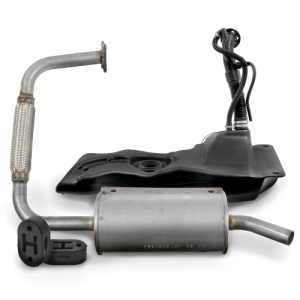Silent exhaust block
Aixam 300 , 400 , 500 , 400evo, 400.4 , 500.4 , 500.5 , A721 , A741 , A751 , City , Roadline , Crossline…
New
In stock
Regular price €4.83 -50% €2.42
All elements related to theexhaust and tank plays a crucial role in performance, security, noise, emissions but also the overall maintenance of your car-free car. Leakage, corrosion or misstretched adjustment can cause loss of power, overconsumption, unpleasant odors or even health risks. It is therefore essential to choose quality pieces and ensure their good condition.
In the Exhaust category / Tank, several types of pieces intervene, each with specific functions and criteria of important quality.
The exhaust comprises the collector, the tubes, the silencer, the exhaust joints, the hose, and the silent-blocks. The muffler attenuates the noise, the tube ensures the circulation of the gases, the collector gathers the outputs of the motor, the seal ensures the sealing, the hose allows some mechanical flexibility, and the silent-blocks reduce vibrations.
The tank stores the fuel, the circuit supplies the engine, and the pipes, plugs, tank joints must be in good condition to avoid leakage, fuel loss or contamination. A poorly closed tank cap can also result in evaporation losses or trigger unwanted odors.
These components influence not only the life of the engine, but also your driving comfort, compliance with standards, acoustic comfort and global security.
A pierced silencer, a split tube or defective collector cause pressure losses in the exhaust gas circuit. This can lead to a decrease in motor torque, increased consumption or increased sound emissions. Acoustic standards impose a certain maximum noise level: a poor state equipment can expose you to contraventions or technical control according to local regulations.
A damaged or poorly sealed tank has fuel leakage risks, which are not only dangerous but also polluting. Similarly, corroded or deteriorated exhausts can release harmful gases more easily. Maintain these parts in good condition helps to comply with pollution standards, preserve health and avoid odors in the passenger compartment.
Identify the symptoms before they get worse prevents expensive breakdowns.
• Strong engine noise or "clicking" during accelerations.
• Strong exhaust odor in or around the vehicle.
• Black smoke or abnormal visible condensations.
• Detectable leaks (drops, noise of breath) at the seals or necklaces.
• Vibration or metal noise linked to a silent-Block or a deteriorated support.
• Odor of fuel at the stop.
• Loss of fuel from the tank or pipelines.
• Difficulty filling the tank or closure of the problematic plug.
• Presence of moisture or rust on or around the tank.
• Malfunction of the fuel gauge (erroneous reading).
A good maintenance involves regular controls, adapted cleaning and quick intervention as soon as a sign appears.
• Visual inspection of silencers, tubes, collectors (rust, fissure).
• Check the exhaust seals and necklaces to detect leaks.
• Test the sound level running and accelerating.
• Check the media and silent-Blocks for vibrations or game.
• Check the exhaust hose if it is cracked or pierced.
• Check the integrity of the cap (sealing, springs).
• Visually control the corrosion or blister tank.
• Observe fuel lines (leaks, cracks, weak welds).
• Check for the functioning of the gauge.
• Examine the fuel circuit at full ones to detect unusual returns or silence.
When a room shows serious signs of wear, the replacement helps restore performance, safety and comfort.
• Allow the vehicle to cool before any intervention (the exhaust heats a lot).
• Disconnect the relevant parts with adapted tools.
• Replace exhaust joints or necklaces according to need.
• Make sure the tubing do not rub against the chassis.
• Check mounting and mounting brackets, silent-blocks to avoid vibrations or noise noises.
• Handling in a well-ventilated place.
• Empty the tank if necessary before disassembly.
• Handle carefully to avoid deteriorating welds.
• Use a compliant plug to ensure sealing.
• Reassemble the pipes properly and check the absence of leakage after filling.
Pro VSP Offers a wide range of exhausts (silent, tubes, collectors, joints, necklaces, hoses) as well as fuel tanks adapted to cars without license. Each product is accompanied by its specifications (dimensions, tube diameter, tank capacity, compatibility) to make sure you make the right choice.
At the same time as the exhaust or tank, consider checking the silent-Blocks, exhaust joints or brackets to ensure sustainable installation. Find the engine and silent parts-block here: Engine parts and silent-Carblock without license.
The cost depends strongly on the type of room, its complexity, access and material used. A complete muffler is more expensive than just seal or necklaces, but its replacement significantly improves the sound comfort and compliance with standards.
• Silent or complete exhaust tube.
• Joints, necklaces, flexible or media.
• Fuel tank.
• Hand-if installation made by a professional.
• POST VERIFICATION-Mounting: No leakage, good assembly, mastered noise.
• Avoid intensive use in wet or salt conditions without regular cleaning.
• Do not expose parts to reproduced shocks or excessive vibrations.
• Clean the external parts of the exhaust to avoid corrosion.
• Use new exhaust joints when replacing for sealing.
• Check the condition of the tank regularly during full.
Also find our community on our forum Avenir VSP !
